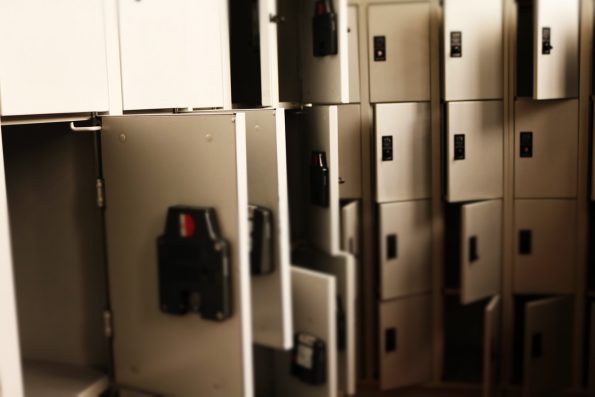
At the outset, smart lockers are a flexible tool that helps secure equipment and workflow management. These have changed how customers shop. The system is beneficial to any business, from a small grocery store to a large multinational corporation.

Source: Paula on Pexels
Introducing the concept of smart lockers
They comprise an integrated computer and sensor mechanism that renders self-monitoring. With that said, these are fully capable of analysing data and automatically making performance changes. They come to serve as secure storage and distribution systems with in-built computer and sensor networks. The lockers can alert you of any irregularities in patterns.
Seems perplexing and confusing, right? Next, read through the evolution of the system.
The evolution of smart lockers
Smart Lockers 1.0: Digital locks
The first movement towards getting smart storage was through digital locks. These were installable onto hardware and operated through a combination mechanical lock. But, they only have one key innovation. These were programmable to cater to both shared and fixed access. What the digital lock system did was enable multiple users to use them. No longer were users set on a lock permanently. The system helped improve equity and asset optimisation.
The system, however, has its flaws. With this, the users could hoard lockers. Also, management cannot monitor which lockers are used, for how long and by whom. As a solution, next up are the hardwired lockers.
Smart Lockers 2.0: Hardwired locker systems
An upgrade to the digital locks, the hardwired locker systems are access systems. The management could operate and monitor the mechanics through a web portal. What this meant was that management could now assign lockers to individuals and their RFID cards. One can keep tabs on who was using them, for how long, and how often.
Although an advanced version of digital lockers, these too have their drawbacks. These are difficult to install and maintain and require intricate wiring within each locker. Additionally, these also require a central console and planned logistics.
Smart lockers 3.0: Wireless lockers systems
The latest version is the wireless lockers. These are app-operated systems. This allows for both shared and fixed use but takes the control and organisation a notch higher. Here’s how! The access is backed with digital receipts and notifications to users. And the best part of these systems is the savings on key or card management. Think of these as audit trails, if you may. What’s more, when paired with a management analytics dashboard, these render a seamless experience for both users and the management.
As advanced systems, wireless lockers are WiFi-less. They are decentralised, meaning that each locker does not need to connect to the Internet or the main power. This decentralisation significantly reduces the occurrences of a system-wide downtime.
Getting to the Core: The components of smart lockers
The Lockers
Whether smart or not, the lockers are reliable storage systems. At the outset, all the lockers look alike. That is, the naked eye cannot easily differentiate between modern and traditional storage lockers. The lockers either have ventilated metal or clear and high-impact polycarbonate doors.
Authentication Panel
Authentication panels are the first component in making that ‘smart’ transformation. With this, you (as in management) can control who can access specific equipment. Starting with the basics – you can choose a PIN code. Note that it is the least secure option. According to security researchers, PIN codes are easy to guess. The reason is that the top 5 per cent of the popular PIN code combinations account for over half of all the actual PIN codes generated and used the world over.
You can set up higher and close-to-impregnable security environments with swipe cards, smartphone applications, and biometrics such as fingerprints, facial or retina scans.
Content Surveillance
Another component that smart locker systems require is the ability to track individual assets. Chief among the most reliable and cost-effective ways is using passive RFID tags. The tags can be attached to or embedded into materials. The locker systems work by reading through these tags and confirming the asset.
Content surveillance can also happen using USB charging cables. When electronic devices get charged or plugged into the USB, the identification gets relayed to the lockers.
Management Software
Pulling out data is one thing, and making meaningful inferences is another! This is where management software comes to the fore. The software helps to present the data concisely and clearly. Next, it gets put onto easy-to-read dashboards on management portals. These portals also enable you to customise and view user and transaction reports, thereby catering to regulatory compliance.
Applications
Apart from retail outlets, smart lockers have several other applications. These are next.
Physical Mobile Device Management

Several companies today rely on staff that use expensive portable devices. For instance, workers use handheld scanners for inventory management in distribution warehouses. The smart lockers help improve handheld scanner management in warehouses. In the event of a mishap or misplacement, the maintenance lockers resolve the damaged equipment.
Evidence Management
Traditionally, it took aeons for law enforcement agencies to conduct investigations and gather forensic evidence. Dedicated evidence managers collect a chain of custody forms and ensure availability on time in court. With smart lockers, the chain of custody is automated. They can operate 24 hours a day, making it possible to track the evidence across all work shifts. The agencies today also have the option of refrigerated locker modules. These help to safely store biological evidence.
Kit Component Checks
Although content surveillance through passive RFID tags is deemed accurate for tagging and scanning multiple items per locker, the kit component checks take it to the next level. With these, you can easily automate and check for EMT medicine bags.
Parting Words
For any corporation that needs storing and tracking of contents, smart lockers make for an excellent solution. Its widespread applications show that smart lockers can resolve challenges for you, irrespective of your domain. The locker systems have leveraged technological innovations and have come a long way.
The post What is a smart locker? appeared first on The Startup Magazine.










